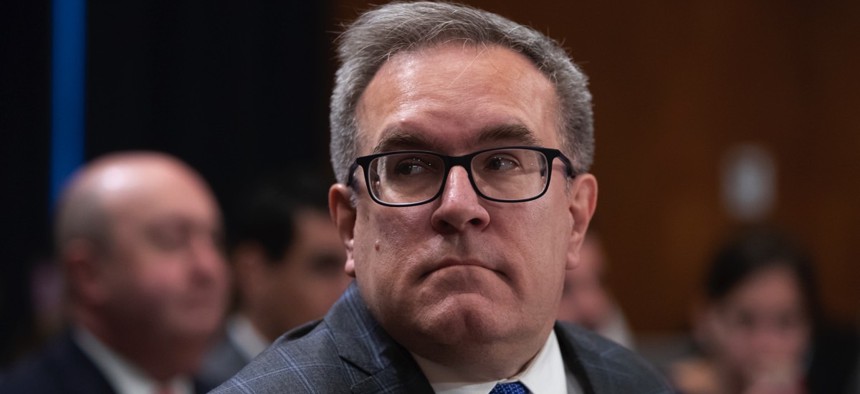EPA Administrator Seeks ‘50-State Solution’ to Fuel Economy Standards

EPA Acting Administrator Andrew Wheeler J. Scott Applewhite / AP Photo
Democratic senators grilled Andrew Wheeler over a draft proposal to freeze limits in model year 2020, against the wishes of California and 13 other states.
UPDATE: The Trump administration on Thursday morning released its long-anticipated plan to roll back car fuel economy standards. Route Fifty's story is here.
WASHINGTON — The Environmental Protection Agency acting administrator stressed Wednesday a proposal expected as soon as this week rolling back Obama-era fuel economy standards is just that—a proposal.
Andrew Wheeler told the Senate Environment and Public Works Committee the Trump administration would welcome a compromise deal between the automotive industry, California and 13 other states using its Clean Air Act waiver.
The waiver allows California to set tougher Corporate Average Fuel Economy standards—50 miles per gallon by 2025—the other states adopted.
“It’s my goal, it’s the administration’s goal, to come up with a 50-state solution,” Wheeler said. “And we want a 50-state solution that does not necessitate preempting California.”
EPA’s current proposal is anticipated to revoke California’s waiver, which is why the state preemptively sued the agency in March over its finding the Obama-era goals are unattainable.
The auto industry doesn’t want a prolonged court battle with California lasting years, nor does it desire to build multiple models for states with different fuel economy standards, said Sen. Tom Carper, a Delaware Democrat. Manufacturers are open to meeting more rigorous standards if it means greater “certainty and predictability,” he said.
“The largest source of air pollution in our country today is not coal-fired utilities, is not manufacturing, is not cement plants,” Carper added. “It is mobile sources.”
If the administration freezes fuel economy standards for seven model years beginning in 2020, as outlined in a draft EPA proposal that recently leaked, pollution emissions will reach 2.2 billion metric tons by 2020—equal to 43 coal-fired power plants, said Sen. Ed Markey, a Massachusetts Democrat.
Wheeler said the amount of emissions was “negligible” between the Obama CAFE standards and Trump administration’s proposal.
“I believe that the analysis shows that more oil would be consumed, but it also will save 12,000 lives and $500 billion,” Wheeler said.
The decrease in traffic fatalities, 1,000 per year, would come because fewer people would choose to drive less fuel-efficient cars, compared to more people getting on the road if the models got better gas mileage, according to the draft proposal.
EPA acknowledges in the draft proposal that 500,000 more barrels of oil will be used daily if standards are frozen, but Markey said that number reaches 2.5 million barrels a day imported from Saudi Arabia and other members of the Organization of the Petroleum Exporting Countries by 2030.
U.S. consumers will spend $20 billion more at the pump in 2025 if standards are frozen, according to the Union of Concerned Scientists.
“That’s money that is transferred right out of the pockets of consumers into the big oil coffers,” Markey said.
Dave Nyczepir is a News Editor at Government Executive’s Route Fifty and is based in Washington, D.C.
NEXT STORY: Lawmakers in Blue States Try to Protect Organized Labor






